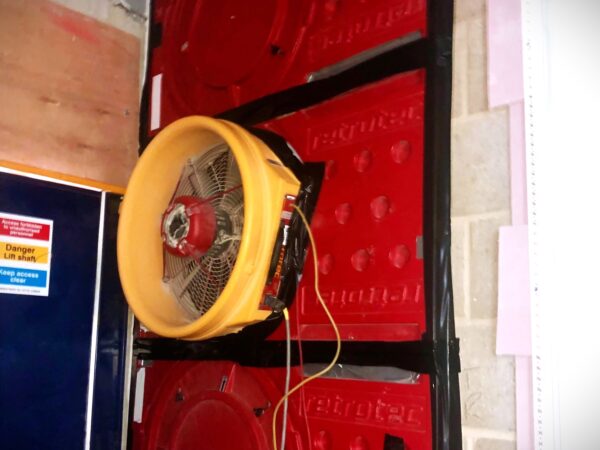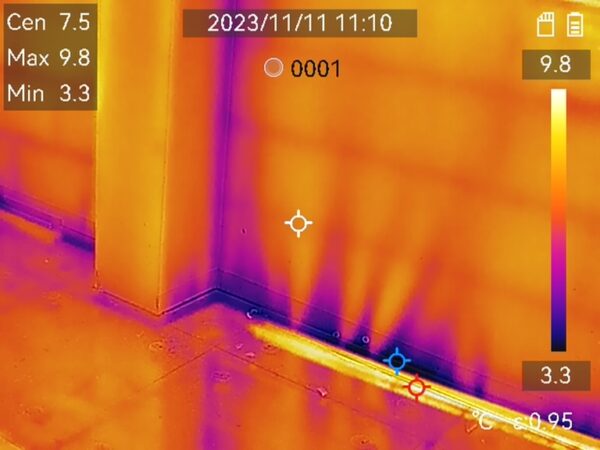So how do you prepare your smoke shaft for an air test? As shafts are at such a high risk of failure, you should seek the advice of UKAS accredited air tightness consultants early on in the process may help you pass your air test at the first attempt!
Regardless of the building materials/type of construction, the best approach is to treat the inside of the shaft as the primary air seal line. As such, the finish inside should be smooth and conscientiously sealed at all junctions and joints, sealing from the outside often leads to blower door air test failures.

Ensure the smoke shaft fabric is sealed
To pass a smoke shaft air test at the first attempt, you must ensure the following areas are carefully sealed.
- Plasterboard – If there is an internal plasterboard finish, this needs to be sealed thoroughly across every joint and screwhead, again paying attention to all junctions and penetrations. Its often best to skim the inner shaft wall as this usually a robust option to maintain the seal line.
- Masonry – All masonry should usually be constructed out of high-grade paint finish blockwork. All mortar joints should be fully filled and pointed. To attain a high level of air tightness its usually best to paint the blockwork with masonry paint and/or render the inside face of the blockwork.
- Service/Structural Penetrations – carefully seal all ductwork and/or structural materials penetrating the inside line of the shaft, you will need to instruct each contractor on the importance of having a good and continuous air seal, paying particular attention to areas that are going to be hard to reach after installation e.g. when a steel supports may be flush against a wall junction or ductwork is close to structural junctions.
- Cable Penetrations – Cable penetrations should be sealed effectively throughout the shaft construction. Large bunches of penetrating cables should be avoided in favour of having a separate penetration for each cable. This approach will enable a good seal to be created with the application of fire sealing to the area. Any cable penetrations behind electrics fittings and control panels need to be effectively sealed before the panel is closed. Make sure that any installation contractors are aware of the importance of this by producing a close our procedure for each floor.
- Conduit Penetrations – Seal around all conduits where they penetrate the shaft wall, it is best practice to seal them inside too. This can be done by opening the conduit where it penetrates the wall.
- AOV Door Frames – The frames or architraves around the AOV openings often present a major leakage path for air, and so should be mastic sealed across the entire perimeter on the inside of the shaft.
- Base and Head of Shaft – Seal the base and head of the shaft, as well as cross section changes may leave openings at soffit level.

How to pass your smoke shaft air test at the first attempt
We have been undertaking AOV smoke shaft testing throughout London and the South-East, on many prestigious projects such as Battersea Power Station, The Imperial War Museum and Claridge’s and Berkeley Hotel.
Our experienced engineers at Air Pressure Testing have over 10 years in the field of smoke shaft testing, so we know how to help clients to pass their testing and achieve smoke shaft signoff.
Our roadmap to a smoke shaft pass:
- Site visit to undertake air leakage survey to smoke shaft
- Air tightness test to your smoke shaft
- Smoke testing in the event of a smoke shaft test failure
- Thermal Imaging in the event of a smoke shaft test failure
- Air tightness test pass for your smoke shaft
Air Pressure Testing Ltd boasts a client base from one of self-builders to the largest construction companies in the UK. We offering leading design, consultancy and compliance for every part of your project, at all stages. It’s APT’s aim to provide a friendly and professional stress-free experience. APT Sound Testing is both UKAS and ATTMA Level 2 accredited to undertake air testing.
We offer leading design, consultancy, and compliance for every part of your project. It’s APT’s aim to provide a friendly and professional stress-free experience.
For more information on our air testing services for smoke shafts, please contact Darren direct on 07775623464, or email us at info@airpressuretesting.net
